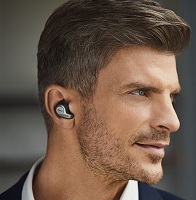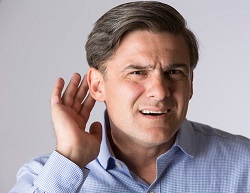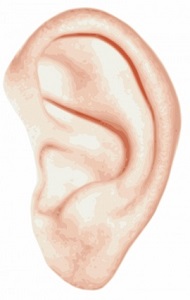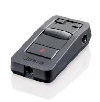There were 3 posts tagged: Hearing
Why We LOVE Headsets
With 10 years in the headset business, headsets are our bread and butter. Of course, it makes sense that we see value in, and appreciate the use of, headsets. We came up with a (brief) list of reasons why we love headsets; and we are curious why others love their headsets. Share the reason why you love your headset on the Comments tab, above.
Headsets increase productivity. Studies show that workers using headsets are up to 40 percent more productive than those who don't. Headsets, especially those with integrated busylights, or used with external Busylights displayed on monitors or cubicle walls, are a clear notifier of status ... red means "do not disturb." Productivity increases without interruption.
Headsets produce clear conversations. Headset microphone technology has been designed to cancel background noise and focus on human voices, for the best possible audio experience.
Headsets protect hearing. Each headset brand has its own patented technology, providing hearing protections that guard against sound spikes and other sound hazards.
 Headsets provide quiet work spaces. If we can't erect walls and a door around our desk, we can put a headset on our ears and block background noise. To really get the benefits of a quiet work space, we suggest an Active Noise Canceling headset. Read a round-up of all of the ANC headsets we offer here: Active Noise Canceling - The New Trend in Office Headsets.
Headsets provide quiet work spaces. If we can't erect walls and a door around our desk, we can put a headset on our ears and block background noise. To really get the benefits of a quiet work space, we suggest an Active Noise Canceling headset. Read a round-up of all of the ANC headsets we offer here: Active Noise Canceling - The New Trend in Office Headsets.
Headsets support correct body alignment and good posture. One of the most important things about body mechanics and posture is alignment: how the head, shoulders, spine, hips, knees and ankles line up with each other. Proper alignment of the body puts less stress on the spine for good posture.
Headsets reduce stress. Noise can cause stress: ringing phones and conversations affect the rhythm and rate of our hearts. Interruptions cause stress. Open offices and the noisy environments they produce cause stress. By sealing yourself away from the noise with a headset, stress levels are lessened.
Headsets are a fashion statement. Headsets can represent a certain cool, edgy, "don't bother me, I'm busy" vibe. And, with all of the wearing styles available today, there truly is a headset for everyone: from ear buds to headbands, and everything in between, you can choose your look.
If you're not feeling the headset love, it may be time for a new, high quality, professional headset. We offer the top brands: Jabra, Plantronics, Sennheiser, BlueParrott, and VXi, and work with our customers to ensure the best fit for each environment and connection type. Give our headset experts a call today at 1-866-998-9991.
Headsets increase productivity. Studies show that workers using headsets are up to 40 percent more productive than those who don't. Headsets, especially those with integrated busylights, or used with external Busylights displayed on monitors or cubicle walls, are a clear notifier of status ... red means "do not disturb." Productivity increases without interruption.
Headsets produce clear conversations. Headset microphone technology has been designed to cancel background noise and focus on human voices, for the best possible audio experience.
Headsets protect hearing. Each headset brand has its own patented technology, providing hearing protections that guard against sound spikes and other sound hazards.
 Headsets provide quiet work spaces. If we can't erect walls and a door around our desk, we can put a headset on our ears and block background noise. To really get the benefits of a quiet work space, we suggest an Active Noise Canceling headset. Read a round-up of all of the ANC headsets we offer here: Active Noise Canceling - The New Trend in Office Headsets.
Headsets provide quiet work spaces. If we can't erect walls and a door around our desk, we can put a headset on our ears and block background noise. To really get the benefits of a quiet work space, we suggest an Active Noise Canceling headset. Read a round-up of all of the ANC headsets we offer here: Active Noise Canceling - The New Trend in Office Headsets.Headsets support correct body alignment and good posture. One of the most important things about body mechanics and posture is alignment: how the head, shoulders, spine, hips, knees and ankles line up with each other. Proper alignment of the body puts less stress on the spine for good posture.
Headsets reduce stress. Noise can cause stress: ringing phones and conversations affect the rhythm and rate of our hearts. Interruptions cause stress. Open offices and the noisy environments they produce cause stress. By sealing yourself away from the noise with a headset, stress levels are lessened.
Headsets are a fashion statement. Headsets can represent a certain cool, edgy, "don't bother me, I'm busy" vibe. And, with all of the wearing styles available today, there truly is a headset for everyone: from ear buds to headbands, and everything in between, you can choose your look.
If you're not feeling the headset love, it may be time for a new, high quality, professional headset. We offer the top brands: Jabra, Plantronics, Sennheiser, BlueParrott, and VXi, and work with our customers to ensure the best fit for each environment and connection type. Give our headset experts a call today at 1-866-998-9991.
Having Trouble Hearing Your Caller? These Headset Tips Can Help
 Hearing loss statistics are staggering: 30 million Americans age 12 and older has hearing loss in both ears. The Better Hearing Institute says that a large number of people wait up to 15 years from the time they know they have hearing loss until they purchase their first hearing aid, usually around the average age of 70 years old.
Hearing loss statistics are staggering: 30 million Americans age 12 and older has hearing loss in both ears. The Better Hearing Institute says that a large number of people wait up to 15 years from the time they know they have hearing loss until they purchase their first hearing aid, usually around the average age of 70 years old.It is easy to blame loud music, headphones and ear buds as the cause of hearing loss; in fact, it is more complicated than that. According to Healthy Hearing, illnesses, head trauma and tumors, prolonged exposure to excessively noisy environments, genetic factors, and some medicines, can all play a part.
Aging is another factor that contributes to hearing loss. Currently, we are seeing an aging workforce: Workers are staying in the workforce past age 65. This is the highest it’s been in 55 years. And, by the year 2024, the Bureau of Labor Statistics estimates that 36 percent of 65-to-69-year-olds will be part of the labor force.
Regularly, we are asked for headset recommendations for hearing aid wearers, and people who are having difficulty hearing calls. Through testing of our own, and daily use of the professional high quality headsets that we sell, we have some tips that will help you find the best set-up for clear calls.
Tip #1: Headsets must be designed for phone calls, not music or gaming. Taking phone calls all day on a headset not designed for human voices can cause problems. And with all-day wear, hearing fatigue can occur over the course of long work days. Beware of consumer-grade headsets that are tuned for music, rather than speech. Proper acoustic tuning in high quality, professional headsets removes noise that is not audible to the human ear, and simultaneously boosts higher frequencies that make fricatives* easier to discern.
Tip #2: We always recommend a dual ear headset. A mono headset covers one ear, leaving the other ear exposed to background noise. With a dual ear headset, both ears are covered, providing Passive Noise Canceling. The amount and degree of Passive Noise Canceling depends upon the shape and size of the ear cushions, and we recommend headsets with ear cushions that completely surround the ear.
Tip #3: If you choose a corded headset, we recommend the purchase of an amplifier, too. Amplifiers are designed to enhance voice quality and call clarity for headset users, boosting the headset's performance. They make sound louder. This technology enables headsets to be used with corded phones and phone systems. In addition to amplifying sound, amplifiers usually include additional features to enhance communication, including mute and volume controls.
Tip #4: Active Noise Canceling headsets may be an option. Active Noise Canceling technology uses one sound to reduce another sound, and is the latest office headset trend. We have compiled a comprehensive list of the ANC headsets from all of our brands: read the ANC Headsets blog post for more information.
We look forward to working with you on finding the best headset for your hearing needs. Our headset experts can be reached at 1-866-998-9991, or by email. After all, Communication Is Our Business!
*Fricatives are consonants that are formed by impeding the flow of air somewhere in the vocal apparatus so that a friction-sound is produced. For instance, the "f" in fine or the "ch" in Bach.
Source:
Are Americans Working Past Retirement Age? Jim Probasco, RothIRA.com
Say What? ActiveGard and other technologies provide hearing protection for heavy phone users
Did you know that headsets can provide hearing protection for the safety and well being of your employees?
Contact center agents, 911 dispatchers, and those who talk on the phone for the majority of their workday are at a higher risk of exposure to acoustic bursts. An acoustic burst is a sudden and unexpected variation in volume level. Noise hazards include white noise, spikes, shrill alarms, fax machine signals and more. When these hazards occur, we cannot react fast enough to pull the receiver away from our ears. Over time, these acoustic bursts can lead to acoustic shock, which causes ear pain, headaches, tinnitus (ringing in the ears) and even permanent hearing loss.
When these hazards occur, we cannot react fast enough to pull the receiver away from our ears. Over time, these acoustic bursts can lead to acoustic shock, which causes ear pain, headaches, tinnitus (ringing in the ears) and even permanent hearing loss.
The United States and the European Union have issued guidelines to protect workers' hearing. The EU Noise at Work Directive defines two critical levels for noise exposure throughout a working day. For up to 80dB(A) the employer has no obligations. Between 80dB(A) and 85dB(A) the employer should offer hearing protection and education. For levels exceeding 85dB the employees must be provided with, and wear, hearing protective equipment. For leading U.S. recommendations, the upper maximum exposure limit is 85 dB(A) (time weighted average over a full working day).
Avcomm Solutions offers three major headset brands: Jabra, Sennheiser and Plantronics. The manufacturers build their headsets with the technologies needed to protect wearer's hearing.
Jabra contact center and office headsets have SafeTone hearing protection, which offers PeakStop and Intellitone technologies, to eliminate potentially harmful sound spikes. PeakStop actively protects the user by keeping the absolute sound level and the energy of the peak in the safe zone at all times, preventing potentially harmful sound from reaching the ear. Intellitone regulates the average sound level down to 85dB.
All Sennheiser contact center and office headsets are equipped with ActiveGard, a patented technology that actively guards your hearing from acoustic bursts or shocks. ActiveGard limits the sound pressure at a level of 103dB (EU and US regulations say maximum 118dB) and reduces and removes dangerous energy from an acoustic burst. It also eliminates the distortion from an excessive incoming signal.
Plantronics contact center and office headsets offer Sound Guard, SoundGuard Plus or SoundGuard Digital technologies, as well as Anti-Startle to protect the headset wearer from sudden loud sounds. AudioIQ and ClearLine technologies are additional hearing safeguard technologies found in Plantronics products. Multistage and limiting technologies ensure hearing is protected during each call.
Another tool in protecting agents' hearing is audio processors, or amplifiers. These offer additional hearing protection technology to enhance the protections found in the headset. Used together, clear conversations, hearing protection, and the best in functionality for corded headsets is possible.
offer additional hearing protection technology to enhance the protections found in the headset. Used together, clear conversations, hearing protection, and the best in functionality for corded headsets is possible.
The variety of headset and amplifier options available on the market today can be confusing to operations directors, contact center managers, and purchasing agents. Contact us at Avcomm Solutions for help in choosing the right set-ups for your organization, and most importantly, your agents. Their hearing safety depends on it!
For more information about hearing technologies, follow the links provided here:
Sennheiser
Jabra
Plantronics
Contact center agents, 911 dispatchers, and those who talk on the phone for the majority of their workday are at a higher risk of exposure to acoustic bursts. An acoustic burst is a sudden and unexpected variation in volume level. Noise hazards include white noise, spikes, shrill alarms, fax machine signals and more.
 When these hazards occur, we cannot react fast enough to pull the receiver away from our ears. Over time, these acoustic bursts can lead to acoustic shock, which causes ear pain, headaches, tinnitus (ringing in the ears) and even permanent hearing loss.
When these hazards occur, we cannot react fast enough to pull the receiver away from our ears. Over time, these acoustic bursts can lead to acoustic shock, which causes ear pain, headaches, tinnitus (ringing in the ears) and even permanent hearing loss.The United States and the European Union have issued guidelines to protect workers' hearing. The EU Noise at Work Directive defines two critical levels for noise exposure throughout a working day. For up to 80dB(A) the employer has no obligations. Between 80dB(A) and 85dB(A) the employer should offer hearing protection and education. For levels exceeding 85dB the employees must be provided with, and wear, hearing protective equipment. For leading U.S. recommendations, the upper maximum exposure limit is 85 dB(A) (time weighted average over a full working day).
Avcomm Solutions offers three major headset brands: Jabra, Sennheiser and Plantronics. The manufacturers build their headsets with the technologies needed to protect wearer's hearing.
Jabra contact center and office headsets have SafeTone hearing protection, which offers PeakStop and Intellitone technologies, to eliminate potentially harmful sound spikes. PeakStop actively protects the user by keeping the absolute sound level and the energy of the peak in the safe zone at all times, preventing potentially harmful sound from reaching the ear. Intellitone regulates the average sound level down to 85dB.
All Sennheiser contact center and office headsets are equipped with ActiveGard, a patented technology that actively guards your hearing from acoustic bursts or shocks. ActiveGard limits the sound pressure at a level of 103dB (EU and US regulations say maximum 118dB) and reduces and removes dangerous energy from an acoustic burst. It also eliminates the distortion from an excessive incoming signal.
Plantronics contact center and office headsets offer Sound Guard, SoundGuard Plus or SoundGuard Digital technologies, as well as Anti-Startle to protect the headset wearer from sudden loud sounds. AudioIQ and ClearLine technologies are additional hearing safeguard technologies found in Plantronics products. Multistage and limiting technologies ensure hearing is protected during each call.
Another tool in protecting agents' hearing is audio processors, or amplifiers. These
 offer additional hearing protection technology to enhance the protections found in the headset. Used together, clear conversations, hearing protection, and the best in functionality for corded headsets is possible.
offer additional hearing protection technology to enhance the protections found in the headset. Used together, clear conversations, hearing protection, and the best in functionality for corded headsets is possible.The variety of headset and amplifier options available on the market today can be confusing to operations directors, contact center managers, and purchasing agents. Contact us at Avcomm Solutions for help in choosing the right set-ups for your organization, and most importantly, your agents. Their hearing safety depends on it!
For more information about hearing technologies, follow the links provided here:
Sennheiser
Jabra
Plantronics

